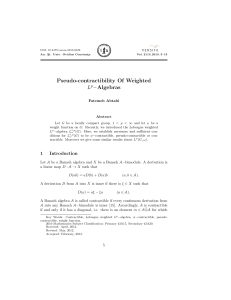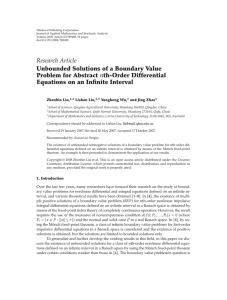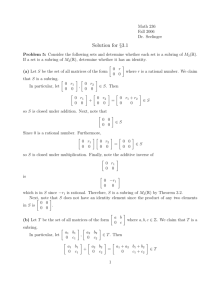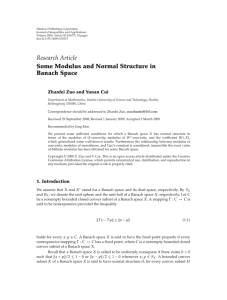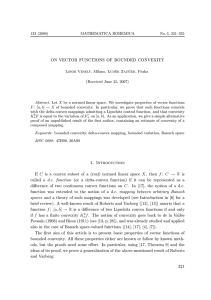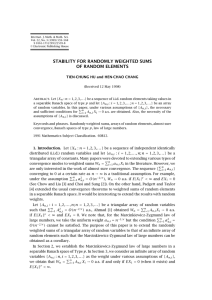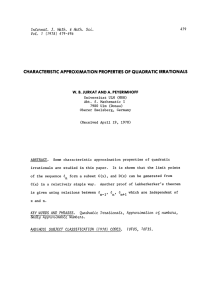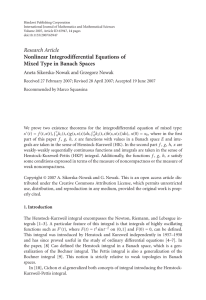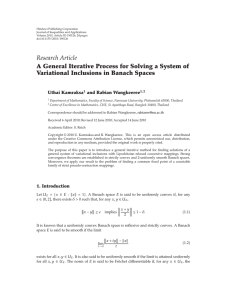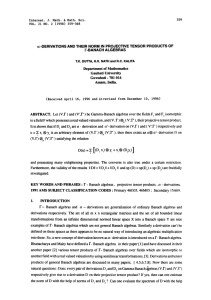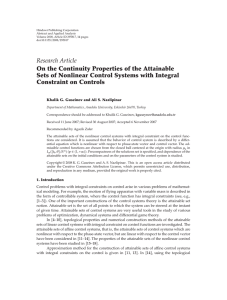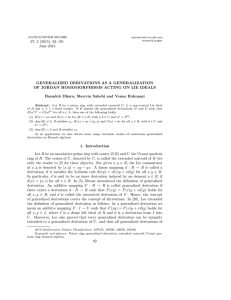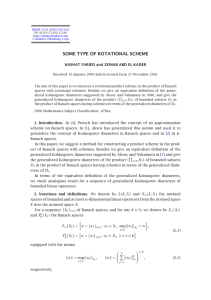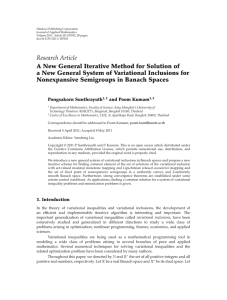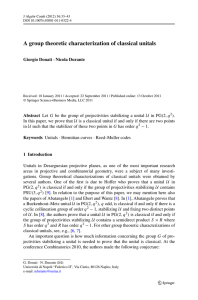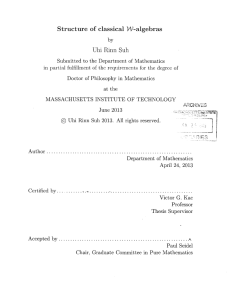Document 10440351
advertisement
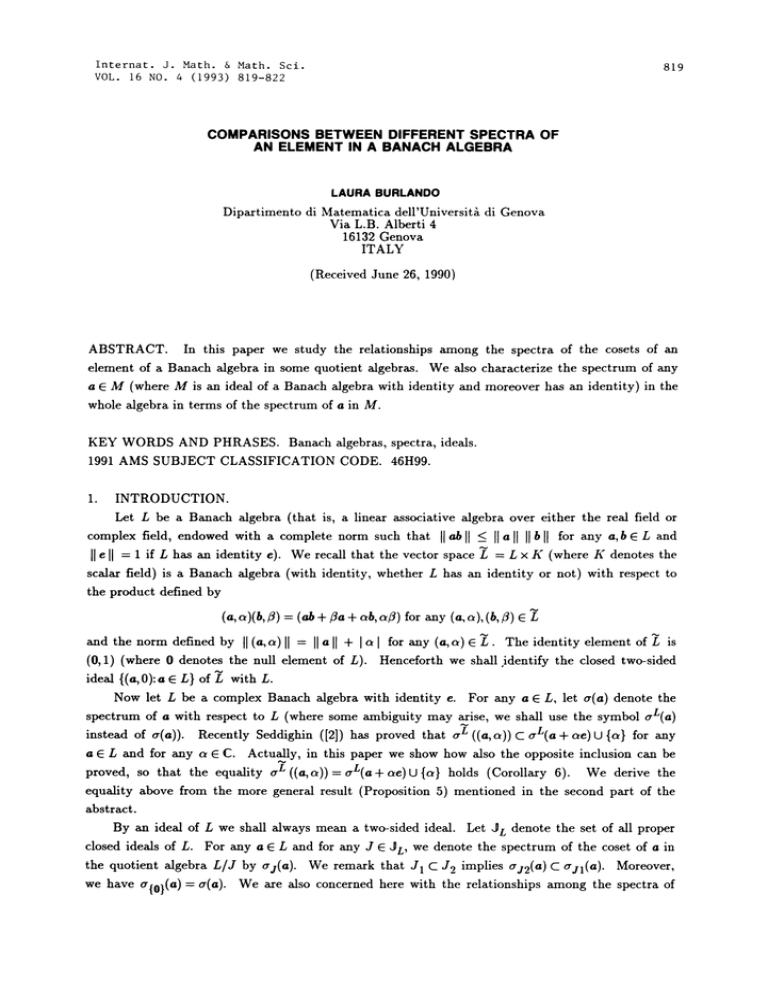
Internat. J. Math. & Math. Sci.
VOL. 16 NO. 4 (1993) 819-822
819
COMPARISONS BETWEEN DIFFERENT SPECTRA OF
AN ELEMENT IN A BANACH ALGEBRA
LAURA BURLANDO
Dipartimento di Matematica dell’Universit di Genova
Via L.B. Alberti 4
16132 Genova
ITALY
(Received June 26, 1990}
ABSTRACT. In this paper
we study the relationships among the spectra of the cosets of an
of
element
a Banach algebra in some quotient algebras. We also characterize the spectrum of any
a E M (where M is an ideal of a Banach algebra with identity and moreover has an identity) in the
whole algebra in terms of the spectrum of a in M.
KEY WORDS AND PHRASES. Banach algebras, spectra, ideals.
1991 AMS SUBJECT CLASSIFICATION CODE. 46H99.
1.
INTRODUCTION.
Let L be a Banach algebra (that is, a linear associative algebra over either the real field or
b for any a, b L and
complex field, endowed with a complete norm such that ab _< a
e
l if L has an identity e). We recall that the vector space
L x It" (where K denotes the
scalar field) is a Banach algebra (with identity, whether L has an identity or not) with respect to
the product defined by
(a, cr)(b,)
.
(ab+ a + ab, a3) for any (a,a),(b,) 6__ L
and the norm defined by (a,a)II
a / I for any (a,a) fi
The identity element of is
(0,1) (where 0 denotes the null element of L). Henceforth we shall .identify the closed two-sided
ideal {(a,0):a L} of L with L.
Now let L be a complex Banach algebra with identity e. For any a L, let a(a) denote the
spectrum of a with respect to L (where some ambiguity may arise, we shall use the symbol aL(a)
instead of a(a)). Recently Seddighin ([2]) has proved that a L ((a,a))C aL(a+ae)U{a} for any
a L and for any a E C. Actually, in this paper we show how also the opposite inclusion can be
proved, so that the equality aI((a,a))=a(a+ae)U{cr} holds (Corollary 6). We derive the
equality above from the more general result (Proposition 5) mentioned in the second part of the
abstract.
By an ideal of L we shall always mean a two-sided ideal. Let
denote the set of all proper
closed ideals of L. For any a L and for any J "L, we denote the spectrum of the coset of a in
the quotient algebra L/J by ad(a). We remark that J1 C J2 implies ad2(a C adl(a ). Moreover,
we have
-a(a). We are also concerned here with the relationships among the spectra of
"L
a{0}(a
L. BURLANDO
820
aE
L in different quotient algebras. In particular,
a(
< <
,SD(a)
show that
we
O <_
<_, aS(a
(Proposition and following remarks) and a( u cS) (a)= 91,i E Ca J(a) (where the symbol "-"
j e
denotes closure) if C is a chain of 3 L (Proposition 4).
2. RESULTS.
PROPOSITION 1. Let L be a complex Banach algebra with identity, let J1,J2 3L and let
a L. Then aj, tq,12(a)
).
PROOF. Let e denote the identity of L. Since J1 J2 Q Jk for any k 1,2, it follows that
a‘1,(a)Oa‘1(a
Sl(a) Uji(a) C J1 J2 (a)"
Now we prove that
J1 flJ2 (a) C jl(a) UaJ2(a ).
Let A (Caj(a))(Caj(a)). Then for y k 1,2 there exist bk
that bt(Ae a) c + uk and (Ac- a)bk e + vk. Consequently,
L and ut, vt e Jt such
(b u)(A-)
-
and
(A- )(
b2,)
+
( + 2)
z.
Since uk, vk Jk for any k 1,2, Ul d V2Vl belong to J1 J2" Hence Ae-a is both left d
right invertible modulo J1 flJ2, which implies that Ac-a is invertible modulo J1 flJ2" Hence
s, as,() c Cs,(,) Cs(,).
We remk that from Proposition
L if J1,...,Jn JL"
Now let S be
(Uj e SaJ (a))- C a(
it follows that
a
may not hold.
a( n <
<,
gt}(a)
U <k<
naJt(a) for y
JL"
J
S
infinite subset of
We remk that the inclusion
j)(a) holds. The following exple shows how the opposite inclusion
EXAMPLE 2. Let B denote the vnit bM1 of the complex ple, d let L denote the Banach
Mgebra of M1 complex-vMued functions which e continuous on B- d holomorphic in B. For
defined by Jn={eL’f(qn)=O} (where {qk}keNcB h cluster
y nN, let gnJL
is
d
in
dense
not
B
in B). We remk that ajn(f
{f(qn)} for y f L d for y
ints
neN. Morver, we have neJn={fL’f(qn)=O for y nN}={0}, f-l(0) flBis a
screte set for y f L{0}. Thus, if a fi L is defined by a(x) z for y z B-, it follows that
e s.()) -"
a. e s")() () (B-) B- ({q.}. e )-
u.
COROLLARY 3.
a
Let L
a
complex Bach Mgebra with identity, let M
JL
d let
e M. Then aj nM(a)= ay(a)U {0} for y J
PROOF. Since a M, we have aM(a)= {0}. Now the result follows immediately from
Proposition 1.
It is not difficult to give an exple of strict inclusion aj(a) aj
Bach Mgebra C 2 endowed with pointwise product. Then, if we set
M
M(a). Let L
denote the
{(0,y)" y e C}, J
{(x,0)" x e C} d a (0,1),
we have that a M, JM= {0} d aj(a)= {1} {0,1} =ajnM(a ).
We remk that the mimM ideals of a Banach Mgebra L with identity
C is a chMn of proper closed ideMs of L, we have that U d e C J)- JL"
e
closed. Hence, if
821
DIFFERENT SPECTRA OF AN ELEMENT IN A BANACH ALGEBRA
PROPOSITION 4. Let L be a complex Banach algebra with identity, and let C be a
nonempty chain of proper closed ideals of L. Then
s e cs(’)
cs)- (a)
(’l
for any aE L.
PROOF.
Let
e denote the identity of L, and let a G L. Since M C U j C J)- for any
e
follows
that
Hence
a( u j ca) (a) C aM(a) for any M C.
n
C
(a)
(a)"
S e C’J
o’( 0 .I cS)
Now we prove the opposite inclusion. We prove that
MEC,
.
it
c\,(
Let
b(e a)
xj- yj
--
cs)- () c c\( o s e c’s("))
C\a(UsecS) -(a)"
Then there exist bL and Xl,X2_(UJcC J) such that
e + x and (e a)b e + x2. Let M C be such that there exist Yl, Y2 e M such that
< for any j 1,2. Then
-)
( .)b
< d
Ul
u
< 1.
Since every element of L whose distance from e is less th one is invertible, it follows that
Hence there exist c,d L such that
’Ae-a)-Yl d (e-a)b-Y2 are invertible in L.
)-
(- )- d
.
Since yj M for y j 1,2, it follows that 2e-a is both left invertible and right invertible
modulo M. Hence e- a is invertible modulo M. Therefore,
CaM(a
We have thus proved that
Ca( u s e cS)
C
C( n j e CaJ (a))"
(a) C Ck(
S
Caj(a)). Hence
cS)- (’0 n s e c"s(’)
We remark that, if L is a complex Banach algebra with identity e and M is a closed subalgebra
of L, also endowed with an identity f, the two identities may not coincide. Moreover, the two
identities are necessarily different if M "L" Nevertheless, the inclusion crL(a) C aM(a)U {0} holds
for any a M in view of [1], (1.6.12). Since aL(a + he) aL(a) + a and aM(a + c.f) aM(a) + a
for any a (/C, also the inclusion aL(a + ae)C aM(a + af)U {a} holds for any a E M and for any
aqC. Thus, in particular, the inclusion aL((a,a))C aL(a+ae)O{o} for any ae L and for any
a E C can be deduced.
PROPOSITION 5. Let L be a complex Banach algebra with identity e, and let M be a proper
ideal of L, endowed with an identity f. Then M E JL (which means that M is closed) and
aL(a + oe) aM(a + af) U {c} (where we set aM(o) O if M {0}) for any a E M and for any
dEC.
PROOF. Let a E M. Since aL(a + he.) aL(a) + a and aM-(a + a.f) aM-(a) + a for any
c E C, it is sufficient to prove that M is closed and crL(a) aM(a)U {0}.
Since f is the identity of M, it follows that f2 f. Since the case M {0} is trivial, we can
suppose M # {0}, which implies 1’ # 0. Moreover, since M is a proper ideal of L, we have that
’(u
822
L. BURLANDO
l e. Hence l is a proper idempotent of L. Then from [1], (1.6.15) it follows that ILl is a closed
subalgebra of L, with identity f, and in ddition a(a) ,,ILl(a) {0}.
Since M E 3 L and E M it follows that fL] C M. Moreover, since f is the identity of M, we
_
have that M IMI C ILl.
We have thus proved that M ILl. Consequently, M G JL and al"(a)= aM(a)U {0}.
The algebras L and M and the element a M introduced in the remark after Corollary 3
aL(a).
provide an example of strict inclusion
Now let the hypotheses of Proposition 5 hold. For any complex-valued function h,
holomorphic on an open neighborhood A of aL(a), let hL(a) L and hM(a) M be defined by
aM(a)C+
+OD
+OD
denotes
the
of
inverse
Ae-a (respectively, Af-a)in L
(respectively,
RL(A,a)
RM(A,a))
(respectively, M), + OD denotes the positively oriented boundary of D and D is an open bounded
subset of C such that aL(a)C D C D- C A, D has a finite number of components and OD consists
of a finite number of simple closed rectifiable curves, no two of which intersect. We recall that the
two integrals above are well defined and do not depend on the choice of D. From the spectral
mapping theorem (see [3], VII, 5.5) and from Proposition 5 it follows that
where
(()) M(U()) {(0)}.
We remark that, actually, the statement above is only seemingly more general than the one of
Proposition 5. In fact, for any A E c\L(a), we have
(e-a)(RM(,a) f/ +e/A)= RM(,a) f +e-aRM(,a) + a/-a/
(f- a)RM(,a) f + e e,
which implies RL(,a) RM(,a) f/A + e/. Hence hL(a) hM(a) h(O)f + h(O)e.
Since any Banach algebra A is a closed proper ideal of A, the following result is a consequence
of Proposition 5.
COROLLARY 6. Let L be a Banach algebra with identity e. Then
.((.,))=.(.+,){}
fo=y.L
=dfo=yC.
Hence the first inclusion proved in [2], Theorem 2.1 can be replaced by
ACKNOWLEDGEMENT. The author wishes to thank Vladimir
shorter proof of Proposition 5.
an
Rakoev’i,
equality.
who suggested her a
REFERENCES
1.
2.
3.
RICKART, C.E., General Theory of Banach algebras, Van Nostrand, 1960.
SEDDIGHIN, M., Supersets for the spectrum of elements in extended Banach algebras,
Inter’nat. J. Math. Math. Sci. 12 (1989), 823-824.
TAYLOR, A.E. and LAY, D.C., Introduction to Functional Analysis, second edition, Wiley,
1980.

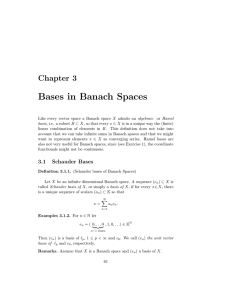

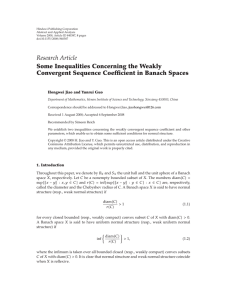
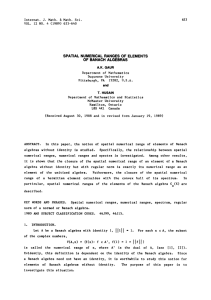
![5.5 The Haar basis is Unconditional in L [0, 1], 1 < 1](http://s2.studylib.net/store/data/010396305_1-450d5558097f626a0645448301e2bb4e-300x300.png)
